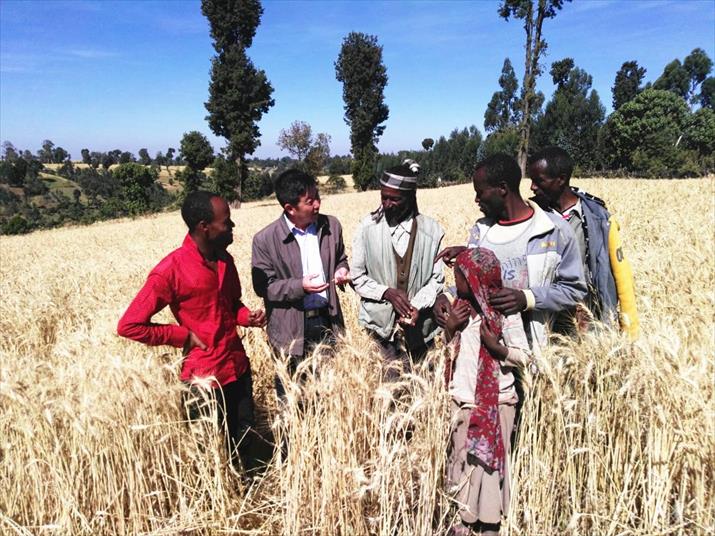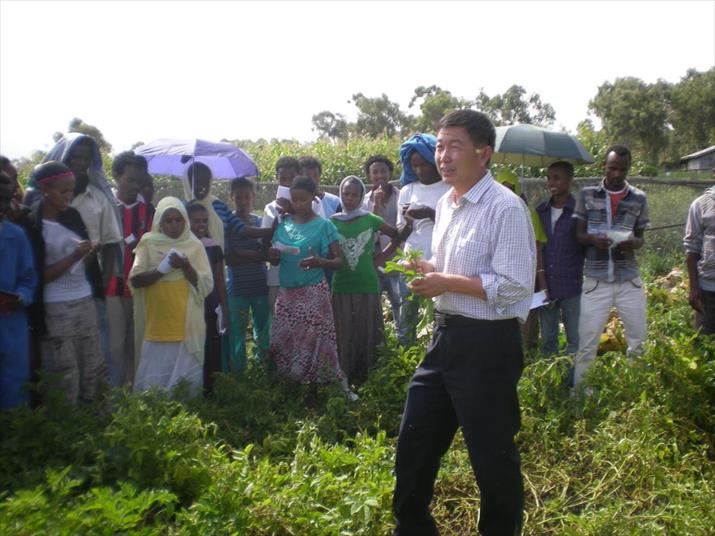|
||||||||||
| Home Nation World Business Opinion Lifestyle ChinAfrica Multimedia Columnists Documents Special Reports |
|
||||||||||
| Home Nation World Business Opinion Lifestyle ChinAfrica Multimedia Columnists Documents Special Reports |
| China |
| Reaping a Good Harvest |
| Ethiopian technicians and farmers improve their wheat cultivation techniques with support from Chinese agricultural experts |
| By Liu Jian | VOL. 9 July 2017 ·2017-07-05 |

"The production of wheat is showing marked improvements following the practical advice given by Chinese agricultural experts," said Selase. "For example, we can increase the seeding rate and apply blended fertilizer to boost crop production."
Selase usually communicates with Liu Jianjun on wheat growing technique. Liu is a 48-year-old wheat expert from the Agriculture and Animal Husbandry Bureau of Zhuolu County in north China's Hebei Province, who is now working in Addis Ababa. "Liu's suggestions are practical and we are considering changing some of our planting methods," he said.
Tech cooperation
Liu is the team leader of the third batch of Chinese senior agricultural experts group to Ethiopia. The work of the experts group is part of the Sino-African technical cooperation projects announced by the Chinese Government at the Fourth Ministerial Conference of the Forum on China-Africa Cooperation in 2009.
Liu and the other seven Chinese agricultural experts were dispatched to Ethiopia in late 2015 for a period of two years, working in the Agricultural Extension Directorate, Ethiopian Ministry of Agriculture and Natural Resources (MANR) in Addis Ababa. These experts specialize in wheat, rice, cotton and edible fungus cultivation, as well as in irrigation machinery operation, sericulture and agricultural products storage and processing.
Fortunately for Liu, he learned the local Amharic language when he spent two years teaching at the Agarfa Agricultural Technical Vocational and Educational Training College in Ethiopia in 2012-14.
What motivated him to learn an African language was to better communicate with those around him.
"No matter if I talk to my colleagues or technicians, it's much easier to use the local language, especially when I speak to local farmers in rural areas," he said.
The experts group landed in Addis Ababa on October 21, 2015. The following day, the team met with Tesfaye Mengiste, Director General of Agricultural Extension Directorate of MANR. Mengiste highlighted the two major bottlenecks that restrict the development of agriculture in Ethiopia: severe backwardness of crop harvesting techniques and a dearth of agricultural mechanization technologies. Liu said helping Ethiopia solve these two problems has naturally become the focus of their work.
While working in the MANR, the Chinese experts also helped with agriculture policy planning and advising, conducted field demonstrations and provided training to local technicians and farmers.
Wheat is one of Ethiopia's most important cereal crops to ensure food security. According to recent statistics, about 4.8 million farmers produce close to 3.4 million tons of wheat across 1.6 million hectares of land in Ethiopia. Both bread and durum wheat varieties are widely grown in the country, constituting around 60 percent and 40 percent of the total wheat production respectively. However, even in high-yield areas, the country's wheat yield is relatively low. How to increase wheat yield is a key concern for Ethiopia's MANR.
After the arrival of Liu and his teammates in Ethiopia, their first task was to conduct extensive and in-depth field research in the first two months. In December 2015, Liu proposed to the MANR to launch a demonstration project of intensive wheat cultivation.
"The demonstration project aims to show the techniques of intensive wheat cultivation, which is widely applied in China, to local farmers and share experiences with technicians, so as to ensure the high yield and good quality of wheat," Liu told ChinAfrica.
After being approved, Liu started the wheat cultivation demonstration project at Gonde-Iteya Basic Seed Farm of the ESE in early 2016. He frequently visited the farm and gave practical advice and guidance to farmers on fertilizer application, sowing, field management and disease control during wheat growth period.
One year's hard work finally paid off. The wheat yield reached 301 kg per mu (0.07 hectares), which is 2.12 times as much as the country's average wheat yield of 141.7 kg of the same unit of wheat land.
"The intensive wheat cultivation techniques Liu applied have not only significantly increased wheat yield, but also improved the quality of wheat. The result is fruitful and impressive." said Selase.
Rolling out training

Training local technicians and farmers is an important work of Liu and his team. So far, more than 100 local experts and technicians have been trained by the Chinese experts.
"The idea is to make sure cultivation techniques are appropriately used by farmers who lack money and management expertise," said Liu.
On March 14, 2017, Liu shared his experience of wheat cultivation with eight Ethiopian agricultural technicians at Gonde-Iteya Basic Seed Farm. After local technicians watched a feature film on wheat planting, Liu explained the key techniques in detail and answered questions.
"This is a lively training session. We not only learnt the wheat production situation in China, but also the differences between our cultivation techniques. The training helps us learn from each other and improve our growing skills," said Zenebe Getachew, Manager of Gonde-Iteya Basic Seed Farm.
Sharing experiences
Seed selection is one of the most important aspects for improving productivity of crops. "In doing that, we must consider local climate, topography, soil conditions and farming rules," said Liu, adding that it is critical to breed high-yield and rust disease-resistant wheat varieties suitable for local conditions, especially since yellow rust, leaf rust and stem rust have been on the rise in Ethiopia in the past few years.
Liu also suggested that crop rotation, which means the successive planting of different crops in a specified order on the same pieces of field, should be promoted in the traditionally wheat dominated farming system in Ethiopia. This would improve soil fertility and reduce weed density, according to him.
Soil nutrients are another source of concern. "The local soil is deficient in several nutrients such as sulfur, boron, zinc and, in some areas, potassium. They are essential for increasing crop productivity and production," he explained.
As the fertilizers widely used in Ethiopia contain only nitrogen and phosphorus and lack other nutrients, Liu suggested that applying basal fertilizers containing those needed elements be the important measure to solve the problem.
Liu also found that outdated traditional methods are the reasons for the low level of agricultural mechanization. Agricultural machinery is mainly used in the large and medium-sized farms, while the traditional plough-sowing method is widely used by local farmers.
Apart from regions like Arsi, Bale and Robe, the Ethiopian terrain is not suitable for using combine harvesters. "It's necessary to promote the use of mini wheat planters and mini threshers," said Liu.
| About Us | Contact Us | Advertise with Us | Subscribe |
| Copyright Beijing Review All rights reserved 京ICP备08005356号-5 京公网安备110102005860号 |